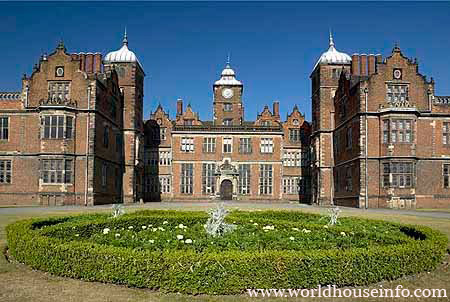Home > United Kingdom famous House > Aston Hall
|
Aston
Hall
Aston Hall is a magnificent Jacobean mansion located in Aston, Birmingham, England. This historic house is renowned for its architectural grandeur, rich history, and cultural significance. In this essay, we will explore the origins, architectural features, notable residents, and the legacy of Aston Hall. The history of Aston Hall dates back to the 17th century when it was commissioned by Sir Thomas Holte, a prominent member of the local gentry. Construction on the mansion began in 1618 and was completed in 1635, making it one of the last great houses of the Jacobean era. The design of Aston Hall was influenced by the architectural styles of the time, combining elements of Jacobean and Carolean design, with a symmetrical façade and ornate detailing.
One of the most striking features of Aston Hall is its impressive exterior. The mansion is constructed of red brick and features a symmetrical façade with projecting wings on either side. The façade is adorned with decorative stone embellishments, including columns, pilasters, and intricately carved friezes. The grand entrance, with its imposing arched doorway and stone steps, welcomes visitors into the magnificent house.
Upon entering Aston Hall, visitors are greeted by a grand central hall known as the Great Hall. This impressive space is characterized by its high ceilings, ornate plasterwork, and a grand staircase leading to the upper floors. The Great Hall serves as the focal point of the house, providing a glimpse into the grandeur and opulence of its past.
Throughout Aston Hall, the rooms are adorned with intricate wood paneling, ornate plasterwork, and elaborate fireplaces, showcasing the craftsmanship and attention to detail of the period. The Long Gallery is another notable feature of the house, stretching over 40 meters in length and providing a space for leisurely strolls and social gatherings. The interiors of Aston Hall exude an air of elegance and refinement, transporting visitors back in time to the golden age of Jacobean architecture. It appears that Aston House, managed by Birmingham City Council and open to the public, is indeed a museum that showcases a series of period rooms with furniture, paintings, textiles, and metalwork from the collections of the Birmingham Museum and Art Gallery. This arrangement allows visitors to experience the historical ambiance and appreciate the artistic elements of the displayed items. Aston Hall is also renowned for its extensive art collection. Over the centuries, the Holte family amassed a remarkable assortment of paintings, sculptures, and decorative art. The collection includes works by renowned artists such as Anthony van Dyck, Peter Lely, and Joshua Reynolds. These artworks provide insights into the cultural and artistic interests of the Holte family, as well as the broader artistic trends of their time.
One of the most notable events in Aston Hall's history occurred during the English Civil War in the 17th century. Sir Thomas Holte, a staunch royalist, defended the mansion against a siege by Parliamentarian forces. The house withstood a three-year siege and was ultimately surrendered in 1646. This event left its mark on Aston Hall, as the house was ransacked and damaged during the conflict. However, subsequent generations of the Holte family restored and preserved the mansion, ensuring its survival and historical significance.
Beyond its architectural and artistic splendors, Aston Hall holds a significant place in the cultural heritage of Birmingham. In 1858, the mansion and its surrounding parkland were acquired by the Birmingham Corporation (now Birmingham City Council), becoming one of the first country houses in England to be preserved as a public museum. Aston Hall opened its doors to the public in 1864, allowing visitors to experience its architectural beauty and learn about its historical significance.
Today, Aston Hall continues to attract visitors from around the world. The house offers a range of exhibits, educational programs, and events, providing opportunities for visitors to engage with the history and heritage of the mansion. Whether exploring the beautifully restored rooms, participating in guided tours, or attending special exhibitions, visitors are transported to a bygone era and gain a deeper appreciation for the cultural legacy of Aston Hall. The surrounding parkland of Aston Hall is also a cherished asset, providing a tranquil oasis amidst the bustling city. The park offers opportunities for leisurely walks, picnics, and outdoor activities, allowing visitors to connect with nature and enjoy the serene surroundings. In conclusion, Aston Hall stands as a testament to the architectural brilliance of the Jacobean era and the historical significance of the Holte family. Its grand façade, opulent interiors, and extensive art collection make it a treasure trove of cultural heritage. As visitors wander through its rooms, admire its artworks, and explore its parkland, they are transported back in time and gain a deeper understanding of the lives of those who resided within its walls. Aston Hall is not just a house; it is a living testament to the enduring legacy of a bygone era and a valuable cultural resource for the city of Birmingham.
|










